


Notice: This is the official website of the All Empires History Community (Reg. 10 Feb 2002)
The Late Byzantine Military (1204-1461) |
Post Reply 
|
Page 123 17> |
| Author | |||
Brainstorm 
Baron 
Joined: 21-Sep-2006 Online Status: Offline Posts: 407 |
 Quote Quote  Reply Reply
 Topic: The Late Byzantine Military (1204-1461) Topic: The Late Byzantine Military (1204-1461)Posted: 11-Oct-2010 at 07:18 |
||
|
Opulsola..it's up to us to revive the Thread. :)
As about the picture you posted... I will post an original image  This is an icon of Christ Pantokrator in Hermitage Museum. It is fine painted , but its historical significance lies in the two figures painted in the bottom corners of it. This icon comes from the Pantokrator Monastery in Mount Athos and dates short after its built in 1357. The two figures depict the founders of the Monastery the brothers Ioannis and Alexios. Ioannis was Megas Primecirius and Alexios Megas Stratopedarches , High Ranks in Byzantine (Romaic) Novelty.  Note the robe with double head eagles and the luxurius hat, identical to the person on the left in the picture u posted. "The title megas stratopedarchēs ("grand master of the camp") was instituted ca. 1255 by the Emperor Theodore II Laskaris (r. 1254–1258) for his chief minister and confidante, George Mouzalon.[5] The mid-14th century Book of Offices of pseudo-Kodinos places the megas stratopedarchēs as the seventh-most senior official of the state below the emperor, ranking between the prōtostratōr and the megas primmikērios. Kodinos claims that he was in charge of provisioning the army, and places four subordinate stratopedarchai under his command: those of the monokaballoi (μονοκάβαλλοι, "single-horsemen"), a cavalry unit; the tzangratores (τζαγγράτορες, "crossbow-men"); the tzakōnes (τζάκωνες, "Tsakonians"), a palace guard originally composed of marines; and the mourtatoi (μουρτάτοι), whom Kodinos presents as palace guards, but whose real nature remains obscure.[4][6] In reality however, in the Palaiologan period the [megas] stratopedarchēs was most likely a mere court title, and did not necessarily entail a military command.[4]" wiki "In the late 11th century, the dignity of megas prim(m)ikērios ("Grand Primicerius") was established, which ranked very high in court hierarchy well into the Palaiologan period, where he functioned as a chief of ceremonies. Primmikērioi continue to be in evidence in the Byzantine Empire and the Despotate of Morea until their fall to the Ottomans.[1]" wiki ---------------- The two brothers governed Christoupolis (modern Kavala) ,Thassos and the surrounding area of Macedonia, to Strymon River from 1365 (maybe 1350) to 1384. They defended and expanded their territory against Serbs and Turks...and asked aid from Venice. Alexios died in 1363, possibly defending Thassos island from the Turks, while his brother finally became a monk in the monastery they built in 1384, probably disappointed and unable to react to the advance of Turks. He died after a couple of years,in 1386. Their tomb and some personal belongings (not the robe though:) ) are still preserved in Pantokrator Monastery in Athos. |
|||
 |
|||
opuslola 
Tsar 
suspended Joined: 23-Sep-2009 Location: Long Beach, MS, Online Status: Offline Posts: 4620 |
 Quote Quote  Reply Reply
 Posted: 14-Apr-2010 at 06:36 Posted: 14-Apr-2010 at 06:36 |
||
|
Tis a shame that this thread died! But, just in case anyone is interested, I would suggest that you take a look at this painting given to us by Jeroen72, a while ago;
http://img262.imageshack.us/i/ter18zp0.jpg/ My inspection of the garments reveals that the Royal and his horse on our right-center wears a covering depicting the "bicephalous" (Eagle or Corvus) which is a symbol of some particular royals. It is also possible that the mounted subject in the left center (Arms bearer?) also exposes a sword that also carries the same symbol. He also displays (held high) the royal septre'! In the above sceen, just what royal family might be represented? Did Byzantium use the two headed black bird symbol? The answer it seems can be found here; http://en.wikipedia.org/wiki/Double-headed_eagle In part the Wiki article says; "After the recapture of Constantinople and the restoration of the Byzantine Empire, the symbol was used as an emblem of the imperial family, but it is uncertain whether it was the official emblem of the Empire. More recent research has suggested that it was not, its usage being limited to imperial seals and other personal or dynasty symbols such as imperial robes, although there has been no depiction of any Emperor wearing it." Indeed? The painting is described thusly; "Easter 1321- Co-emperor Andronicos III assembles an army to overthrow his grand father, Andronicos II." The representations are reportedly created by men who know their history, etc, as well as military attire of the times. But, as of now, I know of no period representations of the "Andronikos" rulers that makes any representation of the "black bi-celphous corvus / eagle!" The source of the above representation is; "All images are from: The Eastern Romans 330-1461 AD By Raffaele D'Amato and Giorgio Albertini - put out by Concord Publications" Regards, Edited by opuslola - 14-Apr-2010 at 07:55 |
|||
|
http://www.quotationspage.com/subjects/history/
|
|||
 |
|||
Heliocles 
Immortal Guard 
Joined: 01-Jan-2008 Online Status: Offline Posts: 8 |
 Quote Quote  Reply Reply
 Posted: 28-Jul-2009 at 12:45 Posted: 28-Jul-2009 at 12:45 |
||
|
These are a couple of temple wall pantings of the late Byzantine period from Crete island:
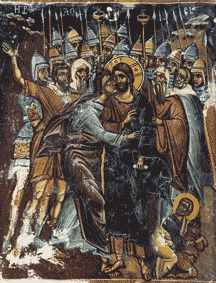 Betrayal, St. George, Artos, Rethymnon, 1401 A.D. 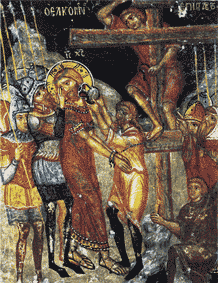 Helkomenos, Panagia, Roustika, 1391 A.D. * http://www.alexandrospress.com/Dated_Byzantine_WallPaintings.htm The armor of the soldiers seems very western-like |
|||
 |
|||
Byzantine Emperor 
Arch Duke 

Kastrophylax kai Tzaousios Joined: 24-May-2005 Location: United States Online Status: Offline Posts: 1800 |
 Quote Quote  Reply Reply
 Posted: 04-Apr-2009 at 19:49 Posted: 04-Apr-2009 at 19:49 |
||
Yes, Michael VIII and Andronikos II made effective use of pronoia grants in the late period. I honestly think this helped the Empire survive over the next two centuries.
After the transfer of the imperial seat and administration back to Constantinople in 1261, the Byzantines basically had to start over because they no longer had a concentration of power in Asia Minor. To think what could have been done if Michael VIII had stayed at Nicaea!
|
|||
 |
|||
Nestorian 
Pretorian 
Joined: 08-Jul-2006 Location: Australia Online Status: Offline Posts: 161 |
 Quote Quote  Reply Reply
 Posted: 03-Apr-2009 at 13:48 Posted: 03-Apr-2009 at 13:48 |
||
|
The pronaiar system is a curious system. Its a hybrid of different systems and principles.
It is part fuedal in that it was suppose to render military service to the ruling Emperor in return for land....and the land's financial (revenue base). In some cases, it was hereditary, throwing another dimension to it.
It is also an informal tax farming system in that the owner is able to extract revenue, that in former times would be collected by the cetnral government, but ceded to the holder.
But, alas, it was a system that reflected the exigencies of the time.
Though retrospectively criticised, it was the best policy at that time by a seasoned and experienced ruler. Its weakness is the lack of competent monitoring or enforcement of effective military duties by the cedee.
|
|||
|
Isa al-Masih, both God and Man, divine and human, flesh and spirit, saviour, servant and sovereign
|
|||
 |
|||
Byzantine Emperor 
Arch Duke 

Kastrophylax kai Tzaousios Joined: 24-May-2005 Location: United States Online Status: Offline Posts: 1800 |
 Quote Quote  Reply Reply
 Posted: 01-Apr-2009 at 06:45 Posted: 01-Apr-2009 at 06:45 |
||
I would not call them "fiefs," because it brings to mind the hereditary land holdings of western medieval knights in the socio-economic phenomenon known as "feudalism."
The late Byzantine pronoia was not the same thing as a fief. It was not part of something that was similar to or influenced by western feudalism. Rather, it was a semi-institutional structure that was developed by the Komnenian and Palaiologan emperors to deal with the decline in resources and manpower from the 11th to 15th centuries.
It was not actual land that was owned and farmed by a lord and his peasants. The Byzantine emperor granted the rights over tax or revenue collection of certain working peasants and buildings in return for some kind of service. It was owned at all times by the State and was revocable by the emperor. Also, it was only by a grant of subsequent privileges that the right became hereditary.
Yes, the stradiotai in Rise of Nations do look rather odd in their plate armor and plumed helmets!
|
|||
 |
|||
Sergeant113 
Janissary 
Joined: 18-Apr-2008 Location: Vietnam Online Status: Offline Posts: 29 |
 Quote Quote  Reply Reply
 Posted: 11-Dec-2008 at 06:27 Posted: 11-Dec-2008 at 06:27 |
||
|
Small pronoia (military fiefs) were occupied by stradiotai, or soldier as Byzantine Emperor mentioned, who were citizens, mercenaries and even prisoners of war. The stradiotai were the main supply of the Byzzie's declining military force, and later, after the loss of Constantinople to the Ottoman, became mercenaries known as stradiotes in western Europe. Their first service was to Venice during the Veneto-Turkish war. Later, seeing the effectiveness of these stradiotes, other Italian city states either directly employed them or hired them for training their own light cavalry troops.
My guess is the cavalry in the Total war and rise of nations series is based more on the later mercenary than the original stradiotai :) Edited by Sergeant113 - 11-Dec-2008 at 06:30 |
|||
 |
|||
Byzantine Emperor 
Arch Duke 

Kastrophylax kai Tzaousios Joined: 24-May-2005 Location: United States Online Status: Offline Posts: 1800 |
 Quote Quote  Reply Reply
 Posted: 16-Nov-2008 at 19:35 Posted: 16-Nov-2008 at 19:35 |
||
Can you be more specific? Despite what the developers of Medieval Total War and Rise of Nations think, there was not a specific unit (discernible from the sources) called stratiotai in the late period. In the latter part of the middle Byzantine period (8th-10th centuries), however, there were cavalry units financed from the revenues of state military lands called stratiotika ktemata. This might be the origin of the late Byzantine method of remuneration called pronoia or oikonomia, in the opinion of the French scholar Paul Lemerle.
See John Haldon and Mark Bartusis for more information. You can access parts of their books on the Byzantine army on Google Books. Edited by Byzantine Emperor - 16-Nov-2008 at 19:40 |
|||
 |
|||
Count Belisarius 
Chieftain 

Magister Militum Joined: 25-Jul-2008 Online Status: Offline Posts: 1109 |
 Quote Quote  Reply Reply
 Posted: 13-Nov-2008 at 00:59 Posted: 13-Nov-2008 at 00:59 |
||
|
I meant as in the cavalry
|
|||

Defenders of Ulthuan, Cult of Asuryan (57 Kills and counting) 
|
|||
 |
|||
Byzantine Emperor 
Arch Duke 

Kastrophylax kai Tzaousios Joined: 24-May-2005 Location: United States Online Status: Offline Posts: 1800 |
 Quote Quote  Reply Reply
 Posted: 12-Nov-2008 at 23:45 Posted: 12-Nov-2008 at 23:45 |
||
Yes, it is the Greek plural word for "soldiers."
|
|||
 |
|||
Count Belisarius 
Chieftain 

Magister Militum Joined: 25-Jul-2008 Online Status: Offline Posts: 1109 |
 Quote Quote  Reply Reply
 Posted: 12-Nov-2008 at 23:31 Posted: 12-Nov-2008 at 23:31 |
||
|
Can anyone tell me anything about the Stratiotai?
|
|||

Defenders of Ulthuan, Cult of Asuryan (57 Kills and counting) 
|
|||
 |
|||
Byzantine Emperor 
Arch Duke 

Kastrophylax kai Tzaousios Joined: 24-May-2005 Location: United States Online Status: Offline Posts: 1800 |
 Quote Quote  Reply Reply
 Posted: 11-Oct-2008 at 22:26 Posted: 11-Oct-2008 at 22:26 |
||
Thanks Akritis and welcome to AE. From what I have heard there are not many pieces extant of late Byzantine armor. Unfortunately the archaeologists of classical Greece have destroyed much of it trying to get at the ancient materials below. Is it a prevailing attitude in Greece that the artifacts from its classical heritage are more valuable than the Byzantine ones?
|
|||
 |
|||
Guests 
Guest 
|
 Quote Quote  Reply Reply
 Posted: 08-Oct-2008 at 14:52 Posted: 08-Oct-2008 at 14:52 |
||
|
I think that this chainmail at Byzantine Museum of Athens is Othoman or persian origin.
Late Byzantine period is a very importand and it is very nice that there is a forum about it.
|
|||
 |
|||
Patrinos 
Baron 

Joined: 05-Sep-2006 Location: Moreas Online Status: Offline Posts: 473 |
 Quote Quote  Reply Reply
 Posted: 15-Sep-2008 at 12:06 Posted: 15-Sep-2008 at 12:06 |
||
|
Nice to find you still here ByzEmp.!
And a real one: It is exhibited in Byzantine and Christian Museum in Athens,and belongs to Ysterobyzantine(Late) period(13th to 15th c.,height 135cm).  Again Saint Theodoros of Terwn,in Byzantine Museum of Athens,15th century.  Edited by Patrinos - 15-Sep-2008 at 12:07 |
|||
|
"Hellenes are crazy but they have a wise God"
Kolokotronis |
|||
 |
|||
Byzantine Emperor 
Arch Duke 

Kastrophylax kai Tzaousios Joined: 24-May-2005 Location: United States Online Status: Offline Posts: 1800 |
 Quote Quote  Reply Reply
 Posted: 14-Sep-2008 at 23:06 Posted: 14-Sep-2008 at 23:06 |
||
|
Patrinos, it is good to see you back at the forum again! Welcome.
The images you posted are really nice. I have seen the frescoes of the the two Theodores before.
The one of Saint George is interesting because of the small rounded shield he carries. This strikes me as being a classicized representation of the shield. By the fourteenth century it was not in use as a functional piece of defensive armor.
Concerning the klibania, Theodore Stratelates' klibanion is an example of the fantastic stylization you see in the late period, with the lamellar pieces in a circular pattern.
I perused the site from which these came and happened upon this image of Saint Merkourios from the Holy Kosmosoteira Church in Ferres, Thrace:
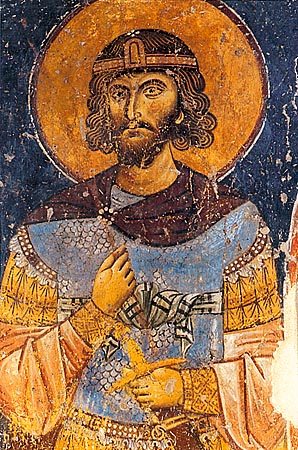 The caption at the site says it was painted in 1152. At any rate, although I could be mistaken, his dress look quite Westernized. Not only does the long-sleeved tunic look this way, but his long curly hairstyle looks like something you would expect to see in England or France in illuminated manuscripts.
|
|||
 |
|||
Patrinos 
Baron 

Joined: 05-Sep-2006 Location: Moreas Online Status: Offline Posts: 473 |
 Quote Quote  Reply Reply
 Posted: 14-Sep-2008 at 22:36 Posted: 14-Sep-2008 at 22:36 |
||
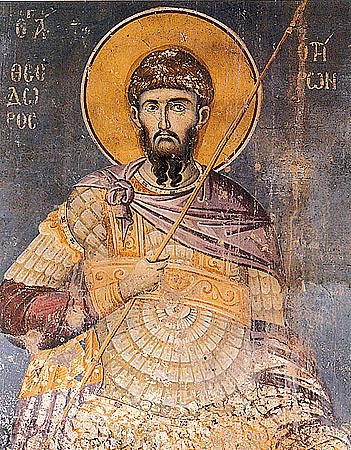 Saint Theodoros Terwn Saint Theodoros Terwn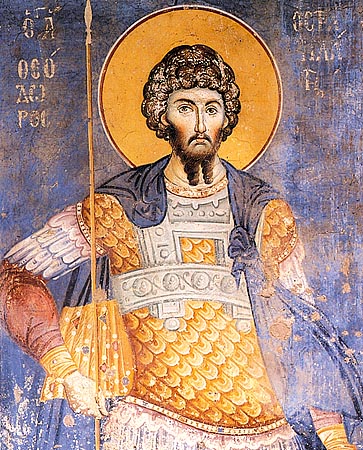 Saint Theodoros o Stratelates Saint Theodoros o Stratelates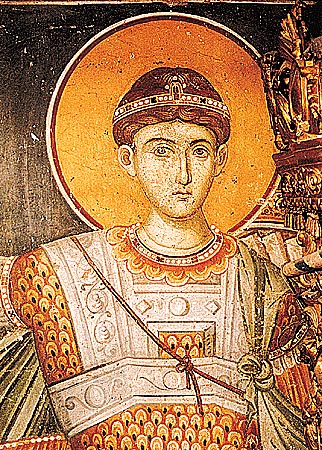 Saint Demetrius Saint DemetriusThese three icons were painted about 1290 in the temple of Prwtatos in Agio Oros(Mount Athos) 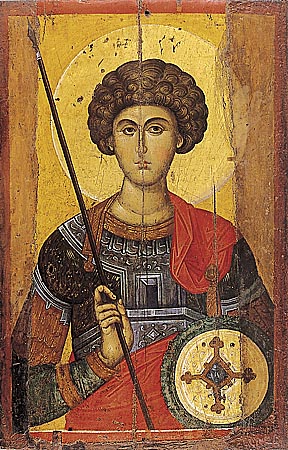 Saint Georgios,icon of 14th cen.,Athens,Byzantine Museum Saint Georgios,icon of 14th cen.,Athens,Byzantine MuseumFollow this link ( http://eib.xanthi.ilsp.gr/gr/icons.asp?cursort=iconTitle&selectFieldValue=&vpage=3 ),it has some interesting,high quality icons. Edited by Patrinos - 14-Sep-2008 at 22:53 |
|||
|
"Hellenes are crazy but they have a wise God"
Kolokotronis |
|||
 |
|||
Benedictus 
Immortal Guard 

Joined: 24-Jul-2008 Location: United States Online Status: Offline Posts: 0 |
 Quote Quote  Reply Reply
 Posted: 01-Sep-2008 at 19:40 Posted: 01-Sep-2008 at 19:40 |
||
I fully agree with this, as it even seems to look a bit like a Roman scutum, with the way it curves around the body. It seems to be a complex blending of the old and new ages with the addition of the mace (scepter?) and the breastplate (looks to be single piece with bronze banding). I, however, cannot tell simply from the black/white image who the image is depicting, and can offer no authoritative opinion on the matter. If it is indeed St. Niketas, is this common in depictions of him? Also, which other saints hold similar descriptions/depictions and include a scepter and shield? Is this common of a "warrior-saint" or is this distinction not set aside from normal saints in Byzantine art history? Edited by Benedictus - 01-Sep-2008 at 19:43 |
|||
 |
|||
Guests 
Guest 
|
 Quote Quote  Reply Reply
 Posted: 19-Aug-2008 at 15:05 Posted: 19-Aug-2008 at 15:05 |
||
|
From what I can tell, it appears to be rectangular, as it does not seem to taper towards the bottom.
|
|||
 |
|||
Byzantine Emperor 
Arch Duke 

Kastrophylax kai Tzaousios Joined: 24-May-2005 Location: United States Online Status: Offline Posts: 1800 |
 Quote Quote  Reply Reply
 Posted: 30-May-2008 at 03:09 Posted: 30-May-2008 at 03:09 |
||
If I am remembering, in this instance we were talking about the siege of Trebizond in 1461. It is doubtful that the fragmentary sources we have in Georgian, Greek, and Latin say much about the ability of the city to defend itself. The walls were indeed high and situated at the top of a hill. Of course, the Ottoman army brought their heavy artillery along. Supposedly the last Grand Komnenos David II ordered a sally out of the gates but was defeated. Later an imperial administrator named George Amiroutzes betrayed the emperor and the city to Mehmet II by surrendering without David's approval.
Well, after the Black Death of the mid 14th century, which hit Constantinople hard, there was a severe population decline in Byzantium and Europe. Combine this with economic stagnation and territorial loss and you have the reasons for the decline of the size of the late Byzantine army.
Thanks for posting the pictures! The black and white picture seems to show possibly Saint Niketas, who is sometimes depicted with a mace among other weapons. The guilded shield is really interesting too. It is hard to tell, but is it a kite shield or rectangular shaped?
The Frankish knight is fascinating. I wonder what the prototype for the Byzantine painter was?
|
|||
 |
|||
xristar 
Chieftain 

Joined: 05-Nov-2005 Location: Greece Online Status: Offline Posts: 1028 |
 Quote Quote  Reply Reply
 Posted: 31-Mar-2008 at 16:41 Posted: 31-Mar-2008 at 16:41 |
||
|
I don't remember exactly, but I remember it was after the fall, thus either late 15th or 16th (more propably). I'm not estimating, it's an official dating.
|
|||

Defeat allows no explanation Victory needs none. It insults the dead when you treat life carelessly. |
|||
 |
|||
Post Reply 
|
Page 123 17> |
| Forum Jump | Forum Permissions  You cannot post new topics in this forum You cannot reply to topics in this forum You cannot delete your posts in this forum You cannot edit your posts in this forum You cannot create polls in this forum You cannot vote in polls in this forum |
Bulletin Board Software by Web Wiz Forums® version 9.56a [Free Express Edition]
Copyright ©2001-2009 Web Wiz
This page was generated in 0.109 seconds.
Copyright ©2001-2009 Web Wiz
This page was generated in 0.109 seconds.












 Printable Version
Printable Version Google
Google Delicious
Delicious Digg
Digg StumbleUpon
StumbleUpon Windows Live
Windows Live Yahoo Bookmarks
Yahoo Bookmarks reddit
reddit Facebook
Facebook MySpace
MySpace Newsvine
Newsvine Furl
Furl Topic Options
Topic Options